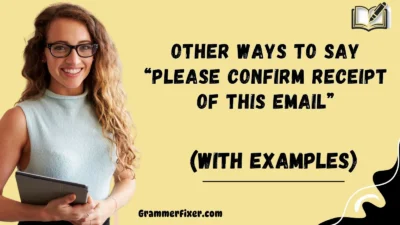Sometimes we find ourselves in heated conversations or challenging interactions where emotions run high. In these moments, it can be tempting to react sharply—but words carry weight. Choosing thoughtful, diplomatic, and respectful language allows us to express boundaries without resorting to vulgarity.
This article explores 30 polite ways to express the sentiment behind “Go F Yourself” while keeping dignity, goodwill, and professionalism intact.
What Does “Go F Yourself” Mean?
The phrase is a blunt, offensive, and vulgar expression often used to dismiss someone, end a conversation, or express anger. At its core, it conveys disrespect, frustration, or the desire for disengagement, but in a way that damages relationships and undermines civility.
When to Use “Go F Yourself”?
Realistically, it’s best not to use it at all. But the feeling behind it—needing space, rejecting offensive behavior, or refusing to engage further—is valid. That’s why finding polite alternatives matters: they let you express boundaries clearly while protecting relationships, professionalism, and your own peace of mind.
Is It Professional/Polite to Say “Go F Yourself”?
No. In both personal and professional settings, this phrase is considered offensive, confrontational, and harmful. However, with polite alternatives, you can still express refusal, set boundaries, or disengage without escalating conflict.
Pros or Cons of Using Polite Alternatives
Pros:
- Maintains professionalism and decorum
- Shows emotional intelligence and maturity
- Prevents escalation of conflict
- Leaves room for future cooperation
Cons:
- May not always convey the same level of intensity
- Can feel indirect or overly polite in casual, joking contexts
- Risk of the message being misinterpreted as soft instead of firm
1. “I Think We’re Done Here.”
Meaning: A firm but polite way to end an interaction.
Explanation: Indicates the conversation no longer serves a purpose.
Scenario Example: “I think we’re done here. Let’s not drag this out.”
Best Use: In professional settings when talks become unproductive.
Worst Use: When speaking to a loved one during a vulnerable or emotional moment—it can come across as cold or dismissive.
Tone: Firm, respectful, and definitive.
2. “Let’s Agree to Disagree.”
Meaning: Signals acceptance of different viewpoints without hostility.
Explanation: A classic phrase for ending a circular or heated debate.
Scenario Example: “We see things differently. Let’s agree to disagree.”
Best Use: Debates, team discussions, or friendships where respect is still valued.
Worst Use: In serious conflicts where unresolved issues must be addressed, like legal or workplace disputes.
Tone: Diplomatic, neutral, respectful.
3. “This Conversation Isn’t Productive Anymore.”
Meaning: Highlights that further discussion won’t lead to resolution.
Explanation: Avoids blame while redirecting focus.
Scenario Example: “This isn’t productive anymore—let’s pause here.”
Best Use: Workplace or group talks going in circles.
Worst Use: During an emotional personal argument (like with a partner) where the other person feels invalidated.
Tone: Professional, tactful.
4. “I’d Prefer Not to Continue This Discussion.”
Meaning: A polite way of setting boundaries while withdrawing from the conversation.
Explanation: Expresses that you’re choosing not to engage further without attacking the other person.
Scenario Example: “I’d prefer not to continue this discussion—it’s not helpful right now.”
Best Use: In professional or personal contexts when emotions are rising.
Worst Use: When someone is sharing something deeply personal—it may feel dismissive of their vulnerability.
Tone: Respectful, boundary-setting, and calm.
5. “I’m Going to Step Away From This Conversation.”
Meaning: Clearly states that you’re disengaging.
Explanation: Communicates the need for space and self-preservation.
Scenario Example: “I’m going to step away from this conversation until things cool down.”
Best Use: When tensions are escalating and you need to preserve peace.
Worst Use: In urgent decision-making scenarios where withdrawal could cause confusion or delay.
Tone: Calm, self-aware, and protective.
6. “Let’s Change the Subject.”
Meaning: Redirects the conversation away from a contentious or sensitive topic.
Explanation: Helps prevent further conflict, discomfort, or offense.
Scenario Example: “Let’s change the subject—this isn’t getting us anywhere.”
Best Use: Social settings where a heated argument would ruin the atmosphere.
Worst Use: When the issue genuinely needs resolution—avoidance may worsen things.
Tone: Light, redirecting, and diplomatic.
7. “That’s Your Opinion, and I Respect It.”
Meaning: Acknowledges the other person’s perspective without agreeing.
Explanation: Shows civility and respect for differences, while creating closure.
Scenario Example: “That’s your opinion, and I respect it—even if I don’t share it.”
Best Use: In debates, discussions, or disagreements where mutual respect matters.
Worst Use: When the other person is being offensive, discriminatory, or abusive—respect isn’t owed there.
Tone: Polite, respectful, and composed.
8. “We’re Not Getting Anywhere With This.”
Meaning: Highlights the stalemate and signals the need to end the discussion.
Explanation: Prevents further frustration by naming the lack of progress.
Scenario Example: “We’re not getting anywhere with this. Let’s stop here.”
Best Use: Workplace or group discussions going in circles without results.
Worst Use: In emotional family conflicts, where it may feel like avoidance of responsibility.
Tone: Direct, practical, and neutral.
9. “I Think It’s Best If We Leave It at That.”
Meaning: A graceful, polite way to close a discussion.
Explanation: Signals finality while avoiding hostility or sarcasm.
Scenario Example: “I think it’s best if we leave it at that and move on.”
Best Use: When trying to close strained conversations gracefully.
Worst Use: In critical negotiations where walking away could cause bigger issues.
Tone: Tactful, composed, and formal.
10. “I Don’t Think This Is Worth My Energy.”
Meaning: Prioritizes your well-being and peace of mind over fruitless arguments.
Explanation: A self-preserving phrase that acknowledges your boundaries.
Scenario Example: “I don’t think this is worth my energy—I’m stepping back.”
Best Use: In online debates, social media arguments, or petty disputes.
Worst Use: When used in serious discussions with colleagues or loved ones—may sound dismissive.
Tone: Honest, protective, and slightly firm.
11. “Let’s Take a Break and Revisit Later.”
Meaning: Suggests pausing to allow emotions to cool before resuming.
Explanation: Creates space and time for reflection, preventing escalation.
Scenario Example: “Let’s take a break and revisit this later when we’re calmer.”
Best Use: Workplace conflicts, team debates, or tense negotiations.
Worst Use: When the matter is time-sensitive or urgent and requires immediate resolution.
Tone: Calm, diplomatic, and strategic.
12. “I’d Rather Not Get Into That.”
Meaning: A polite refusal to engage in a contentious or uncomfortable topic.
Explanation: Sets a clear boundary without hostility.
Scenario Example: “I’d rather not get into that—it’s not helpful right now.”
Best Use: In social conversations where controversial or sensitive topics arise.
Worst Use: When asked for input in professional contexts where silence could seem uncooperative.
Tone: Respectful, boundary-setting, firm.
13. “We’ll Have to Agree to Move On.”
Meaning: Combines agreement with closure, nudging the conversation forward.
Explanation: Encourages progress instead of dwelling on disagreements.
Scenario Example: “We’ll have to agree to move on—this isn’t serving us.”
Best Use: In team discussions or meetings where decisions must be made.
Worst Use: In deep personal arguments where closure requires emotional acknowledgment.
Tone: Practical, decisive, cooperative.
14. “I Respectfully Decline to Continue This.”
Meaning: A polite refusal to participate further.
Explanation: Balances firmness with respectful tone.
Scenario Example: “I respectfully decline to continue this back-and-forth.”
Best Use: In professional emails or workplace discussions that become unproductive.
Worst Use: In casual, joking banter with friends—it may sound overly formal or cold.
Tone: Formal, respectful, assertive.
15. “This Isn’t Worth Arguing Over.”
Meaning: Dismisses the importance of continuing the conflict.
Explanation: Suggests disengagement because the issue doesn’t warrant the energy.
Scenario Example: “This isn’t worth arguing over—let’s drop it.”
Best Use: With friends, family, or colleagues over trivial disagreements.
Worst Use: In serious professional or personal conflicts where stakes are high.
Tone: Casual, firm, slightly dismissive.
16. “I Think It’s Time to End This Discussion.”
Meaning: A direct but polite call to close the conversation.
Explanation: Puts a firm but civil stop to ongoing talks.
Scenario Example: “I think it’s time to end this discussion—it’s not leading anywhere.”
Best Use: In formal settings where civility is key but finality is required.
Worst Use: With close relationships during emotionally vulnerable talks—it may feel harsh.
Tone: Firm, respectful, definitive.
17. “I Don’t See Any Value in Continuing.”
Meaning: Acknowledges that the exchange is no longer beneficial.
Explanation: Points out the lack of progress without personal attack.
Scenario Example: “I don’t see any value in continuing this back-and-forth.”
Best Use: In professional debates or workplace projects where energy needs redirecting.
Worst Use: In family conflicts where the other person may feel invalidated.
Tone: Professional, matter-of-fact, composed.
18. “Let’s End This on a Civil Note.”
Meaning: Encourages graceful closure instead of further hostility.
Explanation: Prioritizes civility and goodwill at the end of a conflict.
Scenario Example: “Let’s end this on a civil note and move forward.”
Best Use: In strained relationships, professional disagreements, or debates.
Worst Use: When the other person is being deliberately offensive—civility may not be appropriate.
Tone: Diplomatic, respectful, peaceful.
19. “I’m Going to Focus My Energy Elsewhere.”
Meaning: Shifts attention away from the negative interaction.
Explanation: A healthy way of redirecting priorities toward productive outcomes.
Scenario Example: “I’m going to focus my energy elsewhere—it’s not worth the stress.”
Best Use: Online arguments, unproductive workplace talks, or toxic encounters.
Worst Use: In serious conversations with loved ones where engagement is necessary.
Tone: Self-aware, constructive, calm.
20. “Let’s Leave It Behind Us.”
Meaning: Suggests moving forward instead of dwelling on conflict.
Explanation: Offers closure and encourages a reset in the relationship.
Scenario Example: “Let’s leave it behind us and move forward.”
Best Use: With friends, colleagues, or partners after disagreements.
Worst Use: When there’s an unresolved serious issue that requires addressing.
Tone: Positive, forgiving, optimistic.
21. “I Don’t Wish to Continue This Right Now.”
Meaning: Signals a temporary boundary while leaving space for later.
Explanation: Shows self-control and avoids escalation by postponing.
Scenario Example: “I don’t wish to continue this right now—let’s revisit when things are calmer.”
Best Use: With friends, family, or colleagues when emotions are heated.
Worst Use: In urgent matters where delays could worsen the outcome.
Tone: Respectful, calm, boundary-setting.
22. “We’re Going in Circles.”
Meaning: Points out the repetitive and unproductive nature of the conversation.
Explanation: Helps both parties recognize that no progress is being made.
Scenario Example: “We’re going in circles—it’s best to stop here.”
Best Use: Workplace meetings, debates, or group discussions.
Worst Use: In emotional conflicts where repetition stems from someone seeking validation.
Tone: Direct, neutral, pragmatic.
23. “I’d Like to End This on Good Terms.”
Meaning: Offers closure with an emphasis on maintaining goodwill.
Explanation: Balances firmness with positive intention.
Scenario Example: “I’d like to end this on good terms, so let’s stop here.”
Best Use: Professional disagreements, workplace negotiations, or friendships.
Worst Use: With someone intentionally offensive or manipulative—it may appear weak.
Tone: Diplomatic, warm, thoughtful.
24. “I’m Choosing Not to Engage Further.”
Meaning: Expresses personal agency in disengaging.
Explanation: Keeps the decision about you, not about blaming them.
Scenario Example: “I’m choosing not to engage further in this conversation.”
Best Use: In online arguments, heated debates, or toxic exchanges.
Worst Use: In team or partnership contexts where collaboration is still necessary.
Tone: Empowered, clear, self-preserving.
25. “I Don’t Think We’ll Reach an Agreement.”
Meaning: Acknowledges the deadlock and provides closure.
Explanation: Avoids further conflict by naming the irreconcilable difference.
Scenario Example: “I don’t think we’ll reach an agreement, so let’s stop here.”
Best Use: Debates, negotiations, or group discussions.
Worst Use: With friends or partners in personal conflicts where compromise is possible.
Tone: Neutral, factual, respectful.
26. “I’m Not Interested in Continuing This Conversation.”
Meaning: A clear boundary expressed with finality.
Explanation: Leaves no ambiguity about disengagement.
Scenario Example: “I’m not interested in continuing this conversation any further.”
Best Use: With toxic people or disrespectful interactions.
Worst Use: With colleagues or loved ones where openness is expected.
Tone: Firm, blunt, but still polite.
27. “Let’s End This Before It Gets Out of Hand.”
Meaning: Prevents escalation by stopping early.
Explanation: Emphasizes wisdom and foresight in pausing.
Scenario Example: “Let’s end this before it gets out of hand.”
Best Use: In heated arguments or rising workplace tensions.
Worst Use: In casual debates where the tone is lighthearted.
Tone: Preventive, firm, calming.
28. “I’d Rather Put My Energy Into Something Positive.”
Meaning: Redirects focus to more constructive use of time and energy.
Explanation: Encourages optimism and self-care.
Scenario Example: “I’d rather put my energy into something positive, so I’m stepping away.”
Best Use: In online arguments, family drama, or toxic conversations.
Worst Use: In serious workplace talks—may seem unprofessional or dismissive.
Tone: Positive, self-aware, and thoughtful.
29. “I Don’t Think This Conversation Is Good for Either of Us.”
Meaning: Recognizes the harm or negativity caused by continuing.
Explanation: Frames the disengagement as mutually beneficial.
Scenario Example: “I don’t think this conversation is good for either of us—let’s pause.”
Best Use: In personal relationships or friendships where emotions run high.
Worst Use: In professional negotiations where constructive resolution is needed.
Tone: Compassionate, respectful, caring.
30. “Let’s End This and Move Forward.”
Meaning: Closes the conversation while keeping the focus on the future.
Explanation: Combines finality with optimism, softening the closure.
Scenario Example: “Let’s end this and move forward—it’s better for both of us.”
Best Use: In strained relationships, workplace disagreements, or family conflicts.
Worst Use: When the issue is unresolved and needs addressing before moving on.
Tone: Optimistic, forward-looking, dignified.
Conclusion
At the end of the day, while the phrase “Go F Yourself” might feel like a quick release in moments of frustration, it rarely leaves us with anything but regret, tension, and broken connections. Choosing a polite alternative allows you to set boundaries clearly, protect your peace, and maintain dignity without fueling conflict or damaging relationships. Whether in a heated workplace discussion, a personal disagreement, or an online exchange, these alternatives give you the tools to disengage gracefully, express yourself firmly, and move forward with a sense of respect, emotional intelligence, and humanity. By practicing these thoughtful responses, you can navigate even the most challenging conversations with wisdom, ensuring that your words leave behind goodwill rather than resentment.



